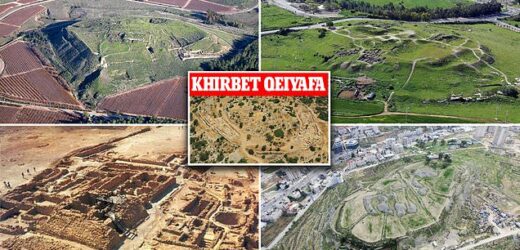Has the kingdom of King David been found? Archaeologist claims five fortified cities near Jerusalem were ruled by the Biblical figure in 1000 BC
- An archaeologist believes five ancient cities were part of a single kingdom
- This kingdom is claimed to have been ruled by King David 3,000 years ago
- READ MORE: Ancient relics are the first definite sign of the Bible’s King David
An archaeologist claims the ruins of five fortified cities outside of Jerusalem belonged to the same kingdom ruled by the Biblical figure King David.
Yosef Garfinkle with the Hebrew University of Jerusalem believes the cities date to the early 10th century BC, some 200 years than previously thought, placing their construction in the time of David.
Garfinkel’s study, published in June, describes the cities all featuring two parallel walls in the center and organized roads, suggesting the network was connected to one kingdom.
While the cities were discovered separately, the archaeologist claims he is the first to connect the dots – determining they are an organized urban network built around 1000 BC.
And King David ruled from 1104 to 960 BC during the Iron Age.
David is said to have been a shepherd boy who became Israel’s third and most crucial king around 1000 BC when he united all the tribes of Israel under a single monarch – but the story has been disputed due to a lack of evidence.
An archaeologist claims the ruins of five fortified cities in Jerusalem are the ruins of a kingdom ruled by the Biblical figure King David. Pictured is one of the ancient cities in Khirbet Qeiyafa
Yosef Garfinkle with the Hebrew University of Jerusalem believes the cities date to the early 10th century BC, some 200 years than previously thought, placing their construction in the time of David
‘I hate to use the term ‘trying to prove the Bible,’ because I’m not trying to prove anything,’ Garfinkel told Times of Israel.
‘There are biblical traditions, and we can see if these have historical memories or not… It doesn’t mean that everything, 100 percent, is historical memories.
‘Sometimes there are mistakes, sometimes there is wishful thinking, sometimes there is ideology.’
The ruins sites are in Khirbet Qeiyafa, Tell en-Naṣbeh, Khirbet ed-Dawwara, Lachish and Beth Shemesh, north and west of Jerusalem.
The fortified city in Khirbet Qeiyafa, excavated from 2007 through 2013, was found to include two gates, two piazzas, a casemate city wall, a peripheral belt of buildings abutting the city wall, a large pillared building and a major public building occupying the highest point of the site.
The ruins sites are in Khirbet Qeiyafa, Tell en-Naṣbeh, Khirbet ed-Dawwara, Lachish and Beth Shemesh, north and west of Jerusalem
The fortified city in Khirbet Qeiyafa was found to include two gates, two piazzas, a casemate city wall, a peripheral belt of buildings abutting the city wall, a large pillared building and a major public building occupying the highest point of the site
A casemate consisted of two thinner, parallel, with empty space between them.
Beth Shemesh is located in northern Shephelah, roughly a day’s walk from Jerusalem and was discovered in 1911.
‘A photograph of this city wall depicts two casemates built of massive stones, as would be expected for a city’s fortification,’ reads the study.
Tell en-Naṣbeh, also a half-day’s walk to Jerusalem, was excavated from 1926 to 1935.
‘A photograph of [Beth Shemesh] depicts two casemates built of massive stones, as would be expected for a city’s fortification,’ reads the study
Beth Shemesh is located in northern Shephelah, roughly a day’s walk from Jerusalem and was discovered in 1911
The city was encircled by a casemate wall, lined by a belt of houses incorporating the casemates as rear rooms; on the other end, these houses opened onto a peripheral road.
Khirbet ed-Dawwara, excavated between 1985 and 1986, was found to have ‘a poorly preserved, short-lived site built on bedrock.’
It comprised a single settlement phase with remnants of four-room houses and a casemate fortification.
Tel Lachish is located in southern Shephelah, approximately two days from Jerusalem.
Tell en-Naṣbeh, also a half-day’s walk to Jerusalem, was excavated from 1926 to 1935
The city was encircled by a casemate wall, lined by a belt of houses incorporating the casemates as rear rooms; on the other end, these houses opened onto a peripheral road.
Seven different expeditions have extensively excavated the site from 1932 until today.
The ancient city was also found to be surrounded by a wall.
Garfinkel determined the age of all five using olive pits found scattered in the ruins, which he did through carbon dating.
Carbon dating ‘is based on the fact that living organisms—like trees, plants, people, and animals—absorb carbon-14 into their tissue,’ according to the University of Chicago.
‘When they die, the carbon-14 starts to change into other atoms over time. Scientists can estimate how long the organism has been dead by counting the remaining carbon-14 atoms.’
While the cities were discovered separately, the archaeologist claimed he was the first to connect the dots – determining they are an organized urban network built around 1000 BC. Pictured is the ruins of Lachish
Tel Lachish is located in southern Shephelah, approximately two days from Jerusalem
Garfinkel also uncovered several proto-Canaanite and Canaanite inscriptions in some of the sites, indicating an increased demand for communication that marks a centralized authority and strong kingdom, he claimed.
Fellow archaeologists are not sold on Garfinkel’s claim.
Professor Aren Maeir, an archaeologist from Bar Ilan University, told The Times of Israel: ‘I think it’s an oversimplification and he is flattening the details.
‘There are a lot of small details I don’t agree with, and there are generalizations over a wide period that are problematic.
‘It’s like when a fisherman tells you about the type of fish he caught and with each story, his arms get wider and wider.
‘Is it a sardine, a mackerel, or a blue whale? If you read the biblical text and take it literally, then it’s a blue whale.
‘I think that probably there was a small kingdom in Jerusalem, but we don’t know the influence that this kingdom had.’
Source: Read Full Article












